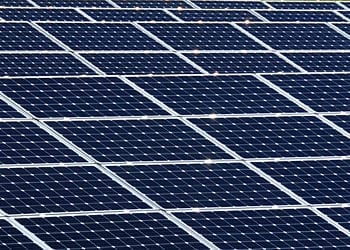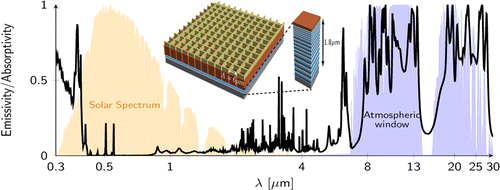
The solar cells can be quickly recycled in water at the end of their lifecycle
Solar cells are just like leaves, capturing the sunlight and turning it into energy. It’s fitting that they can now be made partially from trees.
Georgia Institute of Technology and Purdue University researchers have developed efficient solar cells using natural substrates derived from plants such as trees. Just as importantly, by fabricating them on cellulose nanocrystal (CNC) substrates, the solar cells can be quickly recycled in water at the end of their lifecycle.
The technology is published in the journal Scientific Reports, the latest open-access journal from the Nature Publishing Group.
The researchers report that the organic solar cells reach a power conversion efficiency of 2.7 percent, an unprecedented figure for cells on substrates derived from renewable raw materials. The CNC substrates on which the solar cells are fabricated are optically transparent, enabling light to pass through them before being absorbed by a very thin layer of an organic semiconductor. During the recycling process, the solar cells are simply immersed in water at room temperature. Within only minutes, the CNC substrate dissolves and the solar cell can be separated easily into its major components.
Georgia Tech College of Engineering Professor Bernard Kippelen led the study and says his team’s project opens the door for a truly recyclable, sustainable and renewable solar cell technology.
“The development and performance of organic substrates in solar technology continues to improve, providing engineers with a good indication of future applications,” said Kippelen, who is also the director of Georgia Tech’s Center for Organic Photonics and Electronics (COPE). “But organic solar cells must be recyclable. Otherwise we are simply solving one problem, less dependence on fossil fuels, while creating another, a technology that produces energy from renewable sources but is not disposable at the end of its lifecycle.”
To date, organic solar cells have been typically fabricated on glass or plastic. Neither is easily recyclable, and petroleum-based substrates are not very eco-friendly. For instance, if cells fabricated on glass were to break during manufacturing or installation, the useless materials would be difficult to dispose of. Paper substrates are better for the environment, but have shown limited performance because of high surface roughness or porosity. However, cellulose nanomaterials made from wood are green, renewable and sustainable. The substrates have a low surface roughness of only about two nanometers.
“Our next steps will be to work toward improving the power conversion efficiency over 10 percent, levels similar to solar cells fabricated on glass or petroleum-based substrates,” said Kippelen. The group plans to achieve this by optimizing the optical properties of the solar cell’s electrode.
The Latest Bing News on:
Recyclable Efficient Solar Cells
- Are Solar Panels Recyclable? What You Need To Knowon May 5, 2024 at 6:15 pm
Unless you've had panels installed for decades you probably won't have to figure out a game plan for recycling them, but if you want to, here's how.
- Path to easier recycling of solar moduleson May 3, 2024 at 10:18 am
The use of femtosecond lasers to form glass-to-glass welds for solar modules would make the panels easier to recycle, according to a proof-of-concept study.
- The Rise In Solar Waste Is Only Half The Truthon April 29, 2024 at 3:30 am
The other half of the truth concerns solar panel waste management which brings us to the question: How will we manage this considerable waste?
- Solar PV Waste Recycling: Practical Tips and Solutionson April 29, 2024 at 1:25 am
The recent study by the Council on Energy, Environment and Water highlights India's pressing challenge in managing solar PV waste, projected to reach 600 kilotonnes by 2030. With the majority ...
- Solar power gets cheaper, more reliable for homeownerson April 26, 2024 at 7:52 pm
For most Americans, electricity comes from a company who they pay to keep the current flowing to their house each month. However there may be a more cost effective and sustainable way for nearly ...
- The Dilemma of India’s Solar Wasteon April 26, 2024 at 7:50 pm
The country’s solar capacity is set to increase by four times from 66 GW in 2023 to about 292 GW in 2030. This aligns with India’s COP26 commitment to achieving 500 GW of non-fossil-fuel based energy ...
- Proof of concept study shows path to easier recycling of solar moduleson April 26, 2024 at 10:45 am
The use of femtosecond lasers to form glass-to-glass welds for solar modules would make the panels easier to recycle, according to a proof-of-concept study conducted by researchers at the U.S.
- NREL publishes research into ‘femtosecond’ laser welding process to improve solar module recyclingon April 26, 2024 at 4:39 am
The National Renewable Energy Laboratory (NREL) has published a report on laser welding, which could make solar panels easier to recycle.
- Solar Panel Recycling Market worth $931 million by 2029 - Exclusive Report by MarketsandMarkets™on April 26, 2024 at 3:14 am
The solar panel recycling market is poised for substantial growth in the foreseeable future, driven by a convergence of factors that underscore its critical importance in the transition to a more ...
- Improving solar panel recyclability with laserson April 25, 2024 at 9:06 pm
The National Renewable Energy Laboratory developed a proof of concept for a method to remove polymers from solar panel manufacturing to enable more efficient recycling.
The Latest Google Headlines on:
Recyclable Efficient Solar Cells
[google_news title=”” keyword=”Recyclable Efficient Solar Cells” num_posts=”10″ blurb_length=”0″ show_thumb=”left”] [/vc_column_text]The Latest Bing News on:
Organic solar cells
- $20 Million federal initiative targets low-emission silicon and thin film researchon May 9, 2024 at 9:19 am
The Solar Energy Technologies Office has launched a dual initiative to propel upstream advancements in a collection of solar cell types, and to reduce the emissions of solar-grade polysilicon under 1 ...
- Harnessing Sunlight Like Never Before: Hemispherical Solar Cells Unleash Unmatched Absorptionon May 9, 2024 at 4:17 am
New research suggests redesigning organic solar cells with a hemispherical shell structure to provide broader angular coverage, which is particularly beneficial for devices that need adaptable light ...
- Scientists make advancements with groundbreaking binary organic solar cell technology: 'Highly efficient and stable'on May 8, 2024 at 5:30 pm
The scientists are improving the technology while also making the cells easier to place. Scientists make advancements with groundbreaking binary organic solar cell technology: 'Highly efficient and ...
- Low-energy process for high-performance solar cellson May 7, 2024 at 3:50 pm
Finding reliable, eco-friendly power sources is crucial as our world grapples with increasing energy needs and the urgent call to combat climate change. Solar energy offers one solution, with ...
- Swedish startup wins EU funding to print organic indoor solar panelson May 7, 2024 at 7:55 am
Epishine's organic solar panels harness indoor light to power electronics and Internet of Things (IoT) devices.
- UCSB pioneers a low-energy process for high-performance solar cellson May 6, 2024 at 8:05 am
Researchers at UC Santa Barbara developed a way to make perovskite films at room temperature. This material has emerged as a promising alternative to conventional, silicon solar cells.
- Researchers create 2D all-organic perovskites, demonstrate potential use in 2D electronicson May 6, 2024 at 6:49 am
Perovskites are among the most researched topics in materials science. Recently, a research team from The Hong Kong Polytechnic University (PolyU) has solved an age-old challenge to synthesize ...
- Recent Applications of Polymers in Solar Cellson May 6, 2024 at 4:16 am
Organic photovoltaics has drawn immense attraction in recent years due to advancements in development of new materials. Despite the encouraging efficiency boost witnessed, the technology is still ...
- Researchers pioneer a low-energy process for high-performance solar cellson May 5, 2024 at 5:00 pm
Solar cells made from this material boast many advantages compared ... director of the UCSB Center for Polymers & Organic Solids.
- Scientists Have Developed a Solar Cell You Can Bend and Soak in Wateron April 29, 2024 at 2:45 pm
Researchers at the RIKEN Center for Emergent Matter Science and their partners have created a flexible, waterproof organic photovoltaic film. This innovative film enables solar cells to be integrated ...
The Latest Google Headlines on:
Organic solar cells
[google_news title=”” keyword=”organic solar cells” num_posts=”10″ blurb_length=”0″ show_thumb=”left”]










